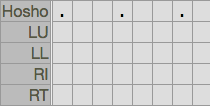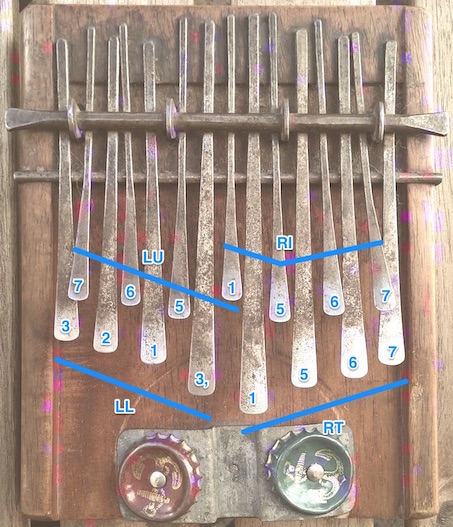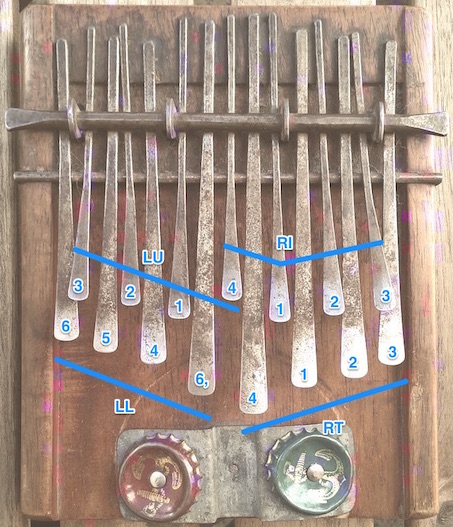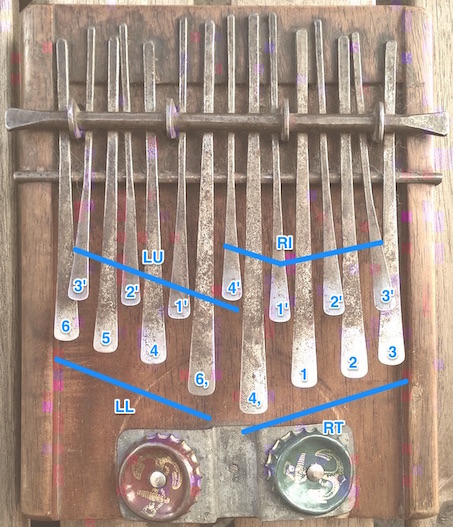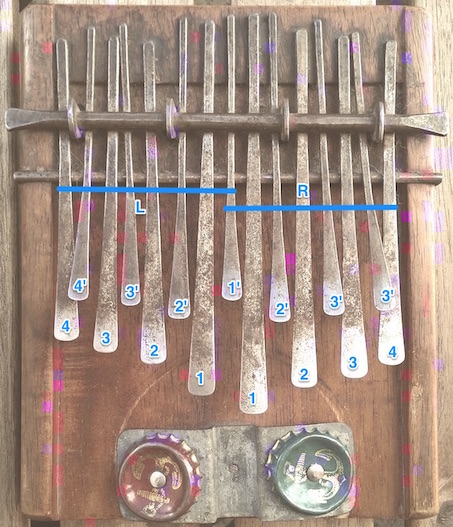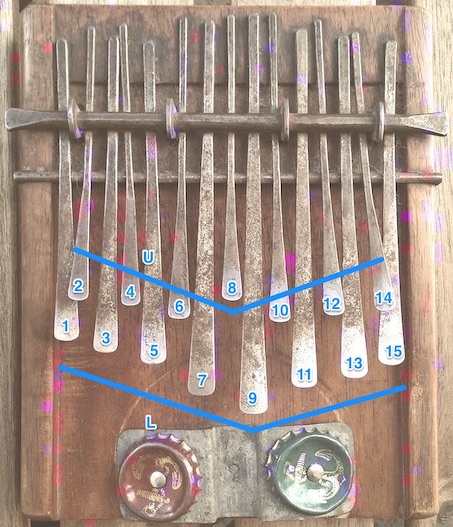The six scale degrees are numbered from
1 to
7,
with the
4th missing.
Key Overview
The table below shows all keys of the notation, from lowest to highest.
Each row contains all possible keys for that playing area.
Each column contains all keys of the same pitch.
Not all instruments may have keys matching all these notes.
Red notes are
alias names
for the same key, if it can be played with different fingers.
| Hosho | . | | | | | | | | | | | | |
| LU | | | | | | | | | | 5 | 6 | 7 | 1 |
| LL | | | 3, | | | | 1 | 2 | 3 | | | | |
| RI | | | | | | | | | | 5 | 6 | 7 | 1 |
| RT | | 1 | 3, | 5 | 6 | 7 | | | | | | | |
Aliases
The table below lists all alias keys.
Row names are shown in black, cell content in red.
| Key | Alias | Notes |
|---|
| LL3, | RT3, | LL3, key played with the right thumb |
| LU1 | RI1 | Highest key in the center, either played with the left thumb or right index finger |
Same numbers as the
Pitch.1 notation, but full octave indication.
Key Overview
The table below shows all keys of the notation, from lowest to highest.
Each row contains all possible keys for that playing area.
Each column contains all keys of the same pitch.
Not all instruments may have keys matching all these notes.
Red notes are
alias names
for the same key, if it can be played with different fingers.
| Hosho | . | | | | | | | | | | | | |
| LU | | | | | | | | | | 5 | 6 | 7 | 1' |
| LL | | | 3, | | | | 1 | 2 | 3 | | | | |
| RI | | | | | | | | | | 5 | 6 | 7 | 1' |
| RT | | 1, | 3, | 5, | 6, | 7, | | | | | | | |
Aliases
The table below lists all alias keys.
Row names are shown in black, cell content in red.
| Key | Alias | Notes |
|---|
| LL3, | RT3, | LL3, key played with the right thumb |
| LU1' | RI1' | Highest key in the center, either played with the left thumb or right index finger |
This is similar to the
Pitch.1 notation,
just counting
4 as the lowest key of the instrument.
Scale degrees are numbered from
1 to
6.
It is the same as the
Pitch+Octaves.4 notation,
with all octave indication omitted where it can be deduced from the playing area.
Key Overview
The table below shows all keys of the notation, from lowest to highest.
Each row contains all possible keys for that playing area.
Each column contains all keys of the same pitch.
Not all instruments may have keys matching all these notes.
Red notes are
alias names
for the same key, if it can be played with different fingers.
| Hosho | . | | | | | | | | | | | | |
| LU | | | | | | | | | | 1 | 2 | 3 | 4 |
| LL | | | 6, | | | | 4 | 5 | 6 | | | | |
| RI | | | | | | | | | | 1 | 2 | 3 | 4 |
| RT | | 4 | 6, | 1 | 2 | 3 | | | | | | | |
Aliases
The table below lists all alias keys.
Row names are shown in black, cell content in red.
| Key | Alias | Notes |
|---|
| LL6, | RT6, | LL6, key played with the right thumb |
| LU4 | RI4 | Highest key in the center, either played with the left thumb or right index finger |
Same numbers as the
Pitch.4 notation, but full octave indication.
Key Overview
The table below shows all keys of the notation, from lowest to highest.
Each row contains all possible keys for that playing area.
Each column contains all keys of the same pitch.
Not all instruments may have keys matching all these notes.
Red notes are
alias names
for the same key, if it can be played with different fingers.
| Hosho | . | | | | | | | | | | | | |
| LU | | | | | | | | | | 1' | 2' | 3' | 4' |
| LL | | | 6, | | | | 4 | 5 | 6 | | | | |
| RI | | | | | | | | | | 1' | 2' | 3' | 4' |
| RT | | 4, | 6, | 1 | 2 | 3 | | | | | | | |
Aliases
The table below lists all alias keys.
Row names are shown in black, cell content in red.
| Key | Alias | Notes |
|---|
| LL6, | RT6, | LL6, key played with the right thumb |
| LU4' | RI4' | Highest key in the center, either played with the left thumb or right index finger |
This is a positional notation which Paul Berliner uses this book
"The Soul of Mbira".
Keys in the upper row are marked with apostrophe.
If right thumb and index finger play keys simultaneously,
transcriptions need two rows labelled
R.
Key Overview
The table below shows all keys of the notation, from lowest to highest.
Each row contains all possible keys for that playing area.
Each column contains all keys of the same pitch.
Not all instruments may have keys matching all these notes.
Red notes are
alias names
for the same key, if it can be played with different fingers.
| Hosho | . | | | | | | | | | | | | |
| L | | | 1 | | | | 2 | 3 | 4 | 2' | 3' | 4' | 1' |
| R | | 1 | L1 | 2 | 3 | 4 | | | | 2' | 3' | 4' | 1' |
Aliases
The table below lists all alias keys.
Row names are shown in black, cell content in red.
| Key | Alias | Notes |
|---|
| L1 | RL1 | L1 key played with the right thumb |
| L1' | R1' | Highest key in the center, either played with the left thumb or right index finger |
In this popular positional notation by Dumisani Maraire
keys are simply numbered 1-15 from left to right, according to their position on the soundboard.
To increase readability, two captions
U and
L are used
for keys in the upper and lower ranks.
If multiple lower keys are played simultaneously, transcriptions need two rows labelled
L.
Key Overview
The table below shows all keys of the notation, from lowest to highest.
Each row contains all possible keys for that playing area.
Each column contains all keys of the same pitch.
Not all instruments may have keys matching all these notes.
Red notes are
alias names
for the same key, if it can be played with different fingers.
| Hosho | . | | | | | | | | | | | | |
| U | | | | | | | | | | 10 | 12 | 14 | RI8 |
| U | | | | | | | | | | 6 | 4 | 2 | 8 |
| L | | 9 | RT7 | 11 | 13 | 15 | 5 | 3 | 1 | | | | |
| L | | | 7 | | | | | | | | | | |
Aliases
The table below lists all alias keys.
Row names are shown in black, cell content in red.
| Key | Alias | Notes |
|---|
| L7 | LRT7 | L7 key played with the right thumb |
| U8 | URI8 | Highest key in the center, either played with the left thumb (U8) or right index finger (URI8)) |
